Ijraset Journal For Research in Applied Science and Engineering Technology
- Home / Ijraset
- On This Page
- Abstract
- Introduction
- Conclusion
- References
- Copyright
Study on Axial Load Carrying Capacity of Concrete-Filled Double Skin Slender Waist-Shaped Stub Column
Authors: Sreelakshmi. T, Divya K K
DOI Link: https://doi.org/10.22214/ijraset.2022.45114
Certificate: View Certificate
Abstract
In the present scenario, concrete-filled steel tubular members have become very popular in the construction industry. These types of members utilize both the advantages of steel and concrete such as the high strength and ductility of steel and the high strength and stiffness of concrete. In the present concrete-filled double skin slender waist-shaped column is used. These columns are composed of two steel tubes such that they are arranged in a concentric configuration with concrete sandwiched between them. It has the ability to impart equal or superior characteristics when compared to traditional concrete-filled steel tubular columns. The finite element method using ANSYS software is used for the study. In this work, the nonlinear structural behavior of CFDST columns is investigated by varying the cross-sectional shapes of steel tubes used. Various parameters that can be evaluated from this study are stress, strain, and deformation values. Comparative results of values of these parameters are obtained.
Introduction
I. INTRODUCTION
Over the years the civil engineering industry has witnessed various types of construction. The increased population and industrial demands for living and working spaces resulted in the construction of high-rise buildings. Using RC members for the construction resulted in bigger-sized members reducing the aesthetic appearance of the structure. This resulted in the evolution of composite structures. Composite construction is one of the varying construction methods. There are different composite constructions. One such construction is the composition of concrete and steel. Composite structures are mainly investigated for high-performance structure design. Concrete filled steel tube was one of the composite structures that replaces the conventional column design in various aspects. The traditional steel reinforcement is replaced by steel tubes into which the concrete is poured. This reduces the time involved in the construction of reinforcement cages and the steel tubes in the column also serve the purpose of formwork eliminating the need for traditional formwork. Concrete-filled steel tubes utilize both the advantage of steel and concrete.
Another innovation in the case of concrete-filled steel tubes is concrete-filled double-skin steel tubes, in which two concentric steel tubes are placed and infilled with concrete between the hollow space. The figure below shows the common type of concrete-filled double-skin steel tubes that are generally used.
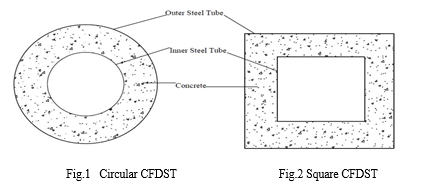
CFDST mainly combines the advantages of concrete-filled steel tubes and a sandwich form resulting in higher bending stiffness, higher section modulus, better damping characteristics, enhanced stability under external pressure, improved cyclic performance, and better fire performance. During fire when compared to CFST the inner tube of CFDST is protected by concrete as a low the thermally conductive material.
The inner cavity of the section not only allows the concentration of materials where needed for optimal performance it also provides space for providing drainage pipes tele communication lines, power cables, etc. when needed. The concrete core present in the CFDST can effectively restrain and delay the local buckling of steel tubes. The tubes act as a longitudinal reinforcement by providing confining effect to the concrete to control the damaged concrete. The presence of these layers and the relation between the tubes and concrete results in a more redundant section which fails only when all the three layers fail. A CFDST section requires less cross-sectional area, hence less self-weight to attain the same axial and bending capacity of conventional RC members. The isolation of concrete core by tubes reduces the maintenance of concrete that may occur.
CFDST was first used as a new form of construction for deep water vessels to resist external pressure. They have long been used as legs of offshore platforms to mitigate stability concerns in hollow steel tubes. Over the recent years, CFDST has been used as a sustainable alternative to existing structural bridge piers and columns of building due to their better characteristics which favor the use as load-bearing structural components.
II. OBJECTIVES
The project aims to develop a CFDST column that can provide improved structural performance while maintaining an overall lightweight structure. To achieve this, the following objectives have been defined:
- To develop CFDST columns to understand the effect of the varying thickness of inner steel tubes.
- To investigate the behavior of CFDST stub columns.
- To evaluate structural deformation and load-carrying capacity of CFDST waist-shaped stub columns with both waist-shaped and inner waist-shaped and outer circular.
III. METHODOLOGY
The methodology of the thesis is divided as follows
A. Modelling
The models are created using ANSYS software. The columns are modeled with different cross-sectional shapes and are analyzed. After analysis, the results obtained are evaluated to find out which cross-sectional shape is better in resisting axial loads. Here the study is to find the behavior of the CFDST column with two different combinations of cross-sectional shapes for steel tubes. It includes both inner and outer steel tubes in waist shape, inner waist shape, and outer circular shape. The material properties are selected based on several sources such as literature reviews and IS code recommendations. The study is carried out using different grades of concrete M25and M60. The steel used is Yst 310 grade confirming IS 1161:2014.
B. Dimensional Details
TABLE I-DIMENSIONAL DETAILS TYPE 1
|
Outer tube |
Length (mm) |
D1 (mm) |
D2 (mm) |
Thickness (mm) |
|
S1 |
1000 |
219.1 |
193.7 |
4.8 |
|
Inner tube |
Length (mm) |
D1 (mm) |
D2 (mm) |
Thickness (mm) |
|
S1 |
1000 |
165.1 |
139.7 |
4.8 |
|
S2 |
1000 |
165.1 |
139.7 |
5.4 |
|
S3 |
1000 |
165.1 |
139.7 |
5.9 |
|
S4 |
1000 |
165.1 |
139.7 |
6.3 |
|
S5 |
1000 |
165.1 |
139.7 |
8 |
TABLE II-DIMENSIONAL DETAILS TYPE 2
|
Outer tube |
Length (mm) |
D1 (mm) |
Thickness (mm) |
|
|
S1 |
1000 |
219.1 |
4.8 |
|
|
Inner tube |
Length (mm) |
D1 (mm) |
D2 (mm) |
Thickness (mm) |
|
S1 |
1000 |
165.1 |
139.7 |
4.8 |
|
S2 |
1000 |
165.1 |
139.7 |
5.4 |
|
S3 |
1000 |
165.1 |
139.7 |
5.9 |
|
S4 |
1000 |
165.1 |
139.7 |
6.3 |
|
S5 |
1000 |
165.1 |
139.7 |
8 |
C. Material Properties and Geometry
The properties of concrete used for the study are as given in the table below. The properties are added as bilinear isotropic material.
TABLE III CONCRETE PROPERTIES
|
Properties |
M25 |
M60 |
|
Young’s Modulus |
25000MPa |
38720Mpa |
|
Compressive ultimate strength |
25Mpa |
60Mpa |
|
Poisson’s Ratio |
0.18 |
0.18 |
The properties of steel used for the study are as given in the table below. The properties are added as bilinear isotropic material.
TABLE IV STEEL PROPERTIES
|
Properties |
Yst 310 |
|
Young’s Modulus |
2x105 |
|
Tensile yield strength |
310Mpa |
|
Tensile ultimate strength |
450Mpa |
|
Poisson’s Ratio |
0.3 |
The geometry of the model used for the study is as follows:
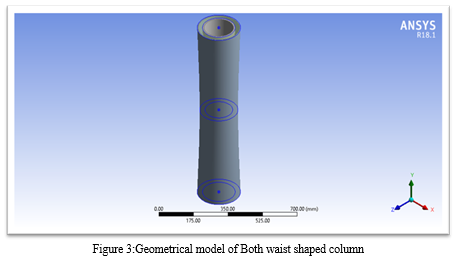
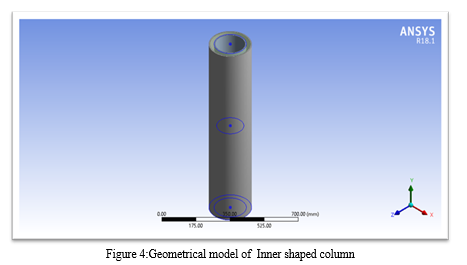
D. Meshing and Loading
The beam is modeled using tetrahedral mesh. The mesh size was provided as 15mm. Loading is provided axially. Axial load is given as displacement-controlled loading at a maximum of 20mm displacement.
E. Analysis Of CFDST Columns
Non-linear static structural analysis was done using ANSYS software. The effect of stress, strain, and deformation on the various cross-sectional shaped columns using M25 and M60 grade concrete is analyzed.
IV. RESULTS AND DISCUSSION
The Result obtained after analysis of the column are as shown below. The maximum load obtained for the CFDST with both waists shaped is the maximum for the thickness of 8mm. The ultimate load for CFDST with M25 grade concrete is 2356.2kN and for M60 is 2781.8 kN for a thickness of 8mm for the inner steel tube. The percentage increase of strength when increase concrete grade is between 17% to 22%. For 4.8mm thickness percentage increase is about 22.05%, for 5.3mm it is decreased to 21.089%, for 5.9mm thickness it is 20.2344%, for 6.3mm it is again reduced to 20.2286%, and finally, for 8mm it decreased to 18.063%.
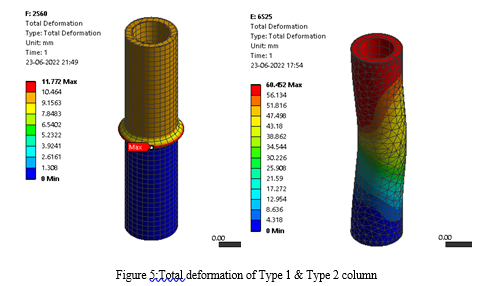
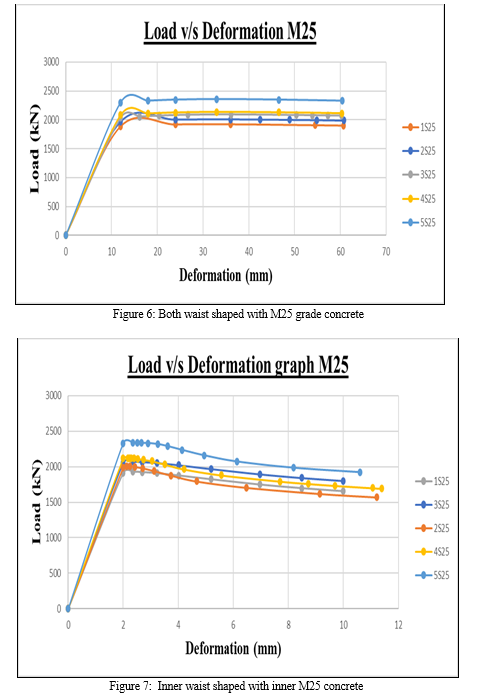
The ultimate load for CFDST with inner waist shape and outer circular with M25 grade concrete is 2333.7kN and for M60 is 2726.9 kN for a thickness of 8mm for the inner steel tube. The percentage increase of strength when increase concrete grade is between 15% to 19%. For 4.8mm thickness percentage increase is about 19.3532%, for 5.3mm it is decreased to 18.616%, for 5.9mm thickness it is 18.0188%, 6.3mm it is again reduced to 17.581%, and finally, for 8mm it decreased to 16.8488%.

In the case of type 1 and type 2 column comparison, type 1 which is of both waist-shaped steel tubes has a higher load-bearing capacity than type 2 with inner waist shape and outer circular steel tube.
TABLE V RESULT OBTAINED
|
Both waist shaped |
inner waist shaped |
||||
|
M25 |
M60 |
% Increase |
M25 |
M60 |
% Increase |
|
1926 |
2350.7 |
22.0509 |
1929.4 |
2303.8 |
19.3532 |
|
2009.5 |
2433.3 |
21.0898 |
2005.8 |
2379.2 |
18.616 |
|
2090.7 |
2513.5 |
20.2344 |
2069.5 |
2442.4 |
18.0188 |
|
2134.6 |
2566.4 |
20.2286 |
2119.9 |
2492.6 |
17.581 |
|
2356.2 |
2781.8 |
18.063 |
2333.7 |
2726.9 |
16.8488 |
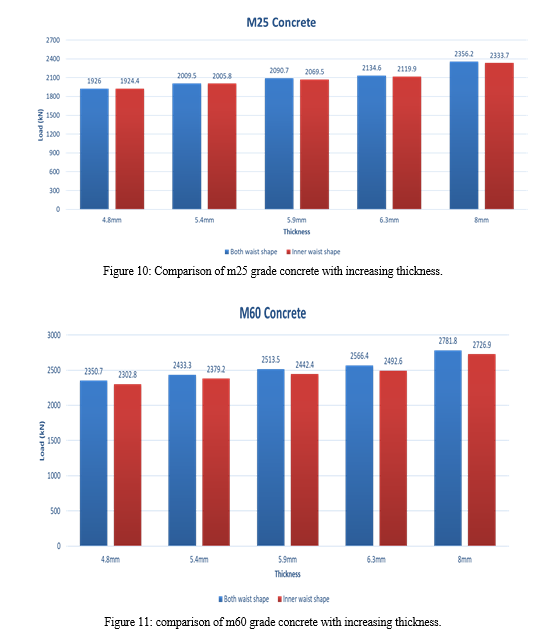
Conclusion
Axial behavior of concrete-filled double skin slender waist-shaped column is studied and the following conclusions are made on the basis of the results obtained. 1) For the increased thickness of the inner steel tube concrete of lower grade can be used instead of a higher-grade concrete. 2) For increasing diameter to thickness ratio strength of column decreases. 3) Column with both inner and outer steel tube of waist shape has a higher load-carrying capacity than outer circular and inner waist shaped. 4) The failure of the column is mainly due to buckling failure.
References
[1] BinghamgHan et.al. “Experimental and numerical study of axial behavior of slender-waist shaped concrete-filled steel tubular stub columns”, International Journal of Scientific Engineering and Research, Volume 171, February 2022. [2] Roshan, Abdul Rehaman “Analysis of Double-Skinned (CFST) Circular and Square columns by Using ANSYS” International Research Journal of Engineering and Technology (IRJET) Volume: 08 Issue: 07 | July 2021 [3] Wen-Da Wang et al., “Experimental and numerical investigations of steel-reinforced concrete-filled steel tubular members under compression-bending-shear loads”, Journal of Constructional Steel Research 181 (2021) [4] Khanh Ba Le, et al. “Circular concrete-filled thin-walled steel tubes under pure torsion: Experiments”, Thin-Walled Structures 164 (2021) [5] KojiroUenaka et al., “Concrete filled double skin circular stub columns under compression”, Thin-Walled Structures 48(2010). [6] M.F.Hassanein et al. “Analysis of circular concrete-filled double-skin tubular slender columns with external stainless-steel tubes”, Thin-Walled Structures 79(2014). [7] Fei-Yu Liao et al, “Experimental Behavior of Concrete-Filled Stainless Steel Tubular Columns Under Cyclic Lateral Loading”; Journal of Structural Engineering, ASCE, ISSN 0733-9445, (2016) [8] Shilpa Sara Kurian et.al, “Study on Concrete Filled Steel Tube”; IOSR Journal of Mechanical and Civil Engineering, e-ISSN: 2278-1684, (2016) [9] S. Mathankumar, M. Anbarasan “Finite Element Analysis of Steel Tubular Section Filled with Concrete”. International Journal of Innovative Research in Science, Engineering and Technology, Volume:05, Issue:06, ISSN: 2347-6710. (2016). [10] Z. Tao, T.Y. Song, B. Uy, L.H. Han,” Bond behavior in concrete-filled steel tubes”, J. Constr. Steel Res. 120 (2016) 81–93. [11] W.Q. Lyu, L.H. Han, Investigation on bond strength between recycled aggregate concrete (RAC) and steel tube in RAC-filled steel tubes, J. Constr. Steel Res. 155 (2019) 438–459. [12] Kalemi B. Numerical modeling and assessment of circular concrete-flled steel tubular members. Master in Science Thesis. Istituto Universitario di Studi Superiori di Pavia; (2016). [13] L. Zhu, L. Ma, Y. Bai, et al., Large diameter concrete-filled high strength steel tubular stub columns under compression, Thin-Walled Struct. 108 (2016) 12–19. [14] ] J.Y.R. Liew, M.X. Xiong, D.X. Xiong, Design of concrete filled tubular beam-columns with high strength steel and concrete, Structures 8 (2016) 213–226
Copyright
Copyright © 2022 Sreelakshmi. T, Divya K K. This is an open access article distributed under the Creative Commons Attribution License, which permits unrestricted use, distribution, and reproduction in any medium, provided the original work is properly cited.

Download Paper
Paper Id : IJRASET45114
Publish Date : 2022-06-30
ISSN : 2321-9653
Publisher Name : IJRASET
DOI Link : Click Here
 Submit Paper Online
Submit Paper Online

